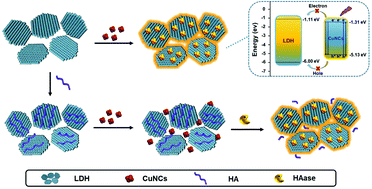Investigation of the surface confinement effect of copper nanoclusters: construction of an ultrasensitive fluorescence turn-on bio-enzyme sensing platform†
Abstract
Copper nanoclusters (CuNCs) have attracted considerable research interest due to their good physicochemical properties, ease of preparation, and low price. However, the low quantum yield and poor stability in aqueous solutions have greatly limited their applications. In order to improve the fluorescence properties and stability of CuNCs, in this paper, the surface confinement effect of CuNCs based on 2D layered double hydroxide (LDH) was proposed to prepare the fluorescent composites of glutathione protected CuNCs and LDH (GS-CuNCs/LDH) with excellent quantum yield and long fluorescence lifetime. Moreover, a novel, simple, and ultrasensitive fluorescence assay for the detection of hyaluronidase was proposed based on the surface confinement effect. The limit of detection for hyaluronidase was as low as 0.014 U mL−1. For the first time, this work developed a bio-enzyme sensing platform based on the surface confinement effect, which can serve as a promising candidate in biosensing.



 Please wait while we load your content...
Please wait while we load your content...